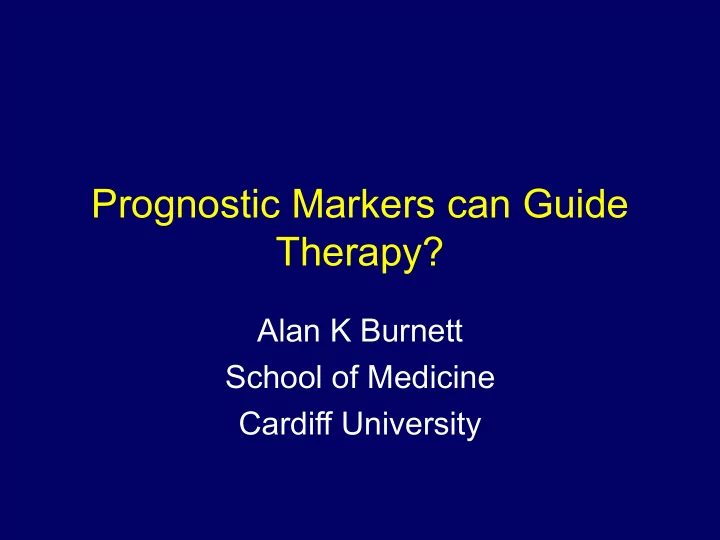

Prognostic Markers can Guide Therapy? Alan K Burnett School of Medicine Cardiff University
NO (t yet)
Prognostic is Not Necessarily Predictive
Prognostic Factor Evolution Multivariate analysis Validation on independent data Test intervention in randomised setting PREDICTIVE
Issues •Is it independent and validated? •Is the assay reliable? •Is it treatment dependent? •Is it practical e.g number of patients / cost •Does it matter? •Does is have consequential implications? •Is the intervention validated?
Prognostic Factors • Age • Cytogenetics • Mutation status • Response to course 1 • Secondary disease • WBC • Male gender • Performance score • Co-morbidity • LDH • MRD
Impact of additional cytogenetic abnormalities: Survival of patients entered into AML 10 & 12 (n=3453) Favourable only (n=478) Favourable + intermediate (n=331) Favourable + adverse (n=22) Intermediate only (n=2235) 100 Adverse + intermediate (n=297) Adverse only (n=478) 75 71% % still alive 65% 59% 50 42% 25 17% 14% 0 0 1 2 3 4 5 Years from entry
Prognostic Factors Mutation status • FLT3 ITD/TK • NPM1 • cKIT • WT1 • CEBPα (double mutant) • EVI1 • MLL • IDH1/IDH2 • Expression (BAALC/MN1)
Results of Cox regression • The following variables are significant (in order of entry to the model): Variable Estimate χ 2 p-value Cytogenetics 0.65082 102.7 <0.0001 Age 0.01325 29.16 <0.0001 Status post C1 0.19529 18.50 <0.0001 WBC 0.00169 11.92 0.0006 Male sex 0.16994 8.01 0.005 Secondary 0.22131 4.03 0.04
Risk Index • The risk index for survival from CR is therefore: 0.01325*age (in years) + 0.16994*sex (1=male, 0=female) + 0.22131*diagnosis (0=de novo, 1 secondary) + 0.65082*cytogenetics (1=favourable, 2=intermediate, 3 adverse) + 0.19529*status post C1 (1=CR, 2=PR, 3=NR) + 0.00169* WBC (x10 9 /l)
Risk Index properties (adults) Maximum Value 4.16 150 Minimum Value 1.27 Low index = low risk Appears to be evidence of two distinct populations 100 t n u Therefore cut the data at o C index=2 (about 15 th percentile) 50 Choose 75 th centile for other cut after looking at splitting into four groups, 0 1.50 2.25 3.00 3.75 so cut at 2.6667 icrnoapl
Outcome by index group
Numbers in Each Group MRC MRC MRC Total Good Standard Poor New good 309 28 0 337 New 51 1289 42 1382 standard New poor 2 274 353 629 Total 362 1591 395 2347
Intermediate Risk: M-B Analysis
Poor Risk: M-B Analysis
What about Molecular Direction?
Prognostic Factors Mutation status • FLT3 ITD/TK 30% • NPM1` 25% (L) • cKIT 25% (L) • WT1 8-10% • CEBPα (double mutant) 2% • EVI1 • MLL • IDH1/IDH2 • Expression (BAALC/MN1)
Survival by FLT3 Mutant Ratio
OS by ITD and NPM1
Intermediate Risk NPM1/FLT3 Genotype: Transplant
Transplant v not – OS (age <50)
Risk Group NPM1/FLT3 Genotype
Excluding the good risk genotype
Bad genotype – standard risk
Comparison of Bad Genotype who are Standard Risk. Good/Standard Poor P-value Age (mean) 37 41 0.2 Sex (male %) 49% 79% .007 WBC (median) 24.1 88.5 .003 Secondary (%) 2% 17% .006 Adverse Cytos 0% 17% <.0001
Comparison of Good Genotype who are Poor Risk. Good/Standard Poor P-value Age (mean) 41 52 <.0001 Sex (male %) 37% 70% .0002 WBC (median) 18.2 77.4 <.0001 Secondary (%) 2% 16% .0002 Adverse Cytos 0% 8% .0008
Regression Equation Index= 0.707 * cytogenetics (1=interm./favourable, 2=adverse) + 0.275 * WBC group (1=<10.0, 2=10.0-99.9, 3=100+) + 0.191 * WHO PS + 0.0315 * age + 0.336 * AML type ( 1=de novo , 2=secondary)
AML14: Overall survival
What about MRD?
What about MRD? •Specificity •Reproducability •Time point vs sequential •Intervention implications •Direct /indirect consequences •How to validate the clinical value
Summary •Not all prognostic factors are validated. •A few change therapy e.g cytogenetics/ marrow response after induction/ FLT3 NPM1 mutations. •Several are prognostic but only in a small population •While prognostic we need to do the studies for predictive validation
Recommend
More recommend